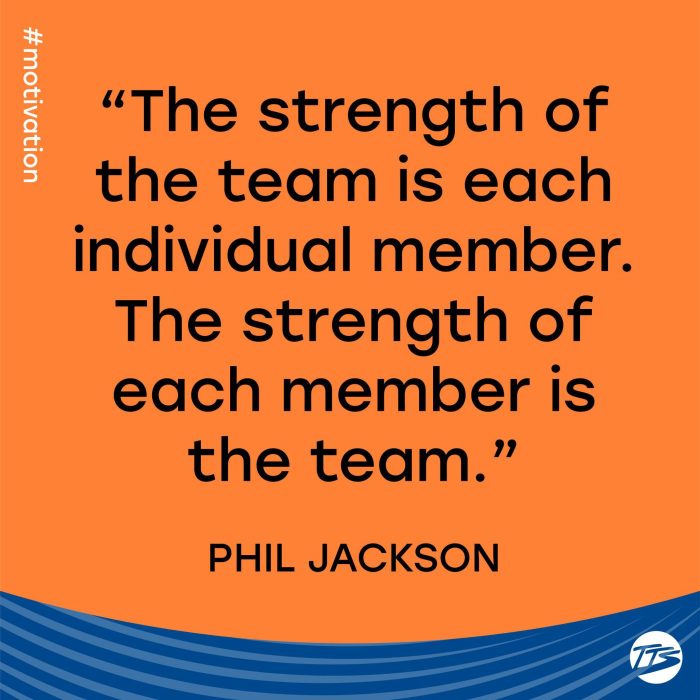How to inspire your team? It’s not just about motivational posters and pep talks. This comprehensive guide dives deep into the heart of team dynamics, exploring practical strategies to cultivate a truly inspiring work environment. From understanding the unique needs of diverse teams to fostering a growth mindset, we’ll equip you with actionable insights to elevate your team’s performance and morale.
We’ll explore various aspects, from identifying and addressing conflicts to setting meaningful goals and objectives. We’ll also examine the critical role of leadership, communication, and celebrating successes, highlighting practical techniques to inspire your team through vision, purpose, and individual strengths. Get ready to transform your team into a high-performing, motivated unit.
Understanding Team Dynamics
Team dynamics are the intricate interplay of interpersonal relationships, communication styles, and working processes within a team. Understanding these dynamics is crucial for leaders to foster a collaborative environment, maximize individual contributions, and achieve shared goals. A well-functioning team is more than just a collection of individuals; it’s a complex system where each member’s unique qualities and perspectives are leveraged for collective success.Effective team dynamics are characterized by open communication, mutual respect, and a shared commitment to common objectives.
This leads to higher levels of productivity, creativity, and employee satisfaction. Conversely, poorly managed dynamics can result in conflicts, reduced output, and decreased morale. Understanding and addressing these dynamics is essential for inspiring and motivating your team.
Diverse Team Structures and Challenges
Teams come in various forms, each with its own set of unique challenges. Project teams, cross-functional teams, and virtual teams all face distinct hurdles. Project teams, for example, are often temporary and focused on a specific objective. Their dynamic can be strained by conflicting deadlines or differing expectations of project deliverables. Cross-functional teams, which bring together individuals from various departments, can encounter difficulties due to varying priorities and communication styles.
Virtual teams, dispersed geographically, require robust communication strategies to overcome the challenges of time zone differences and lack of face-to-face interaction. These varied structures require tailored approaches to manage their specific dynamics effectively.
Identifying and Addressing Potential Conflicts
Identifying and resolving conflicts within a team is critical to maintaining a productive and positive atmosphere. Common conflict triggers include differing work styles, personality clashes, and competing priorities. Strategies for conflict resolution include active listening, clear communication, and establishing a neutral ground for discussion. Facilitating open dialogue and providing a safe space for team members to express their concerns and perspectives are crucial steps in addressing potential conflicts.
Open Communication Channels for Collaboration
Open communication channels are vital for fostering a collaborative environment. This involves actively listening to team members, encouraging open dialogue, and providing clear and concise information. Utilizing various communication tools, such as regular team meetings, instant messaging platforms, and shared project management software, can facilitate efficient information sharing and problem-solving. Transparent communication builds trust and ensures that everyone is on the same page, contributing to a sense of unity and shared purpose.
Boosting team morale is key to success, and sometimes a little hydration can go a long way. Did you know that coconut water offers more than just a refreshing drink? It’s packed with electrolytes and other surprising benefits, like aiding in muscle recovery. Check out these fascinating facts about 8 benefits coconut water you didnt know about – incorporating it into your team’s routine might just be the spark they need to keep their energy levels up and creativity flowing, ultimately leading to a more motivated and productive team.
Shared Goals and Team Motivation
Shared goals are fundamental to team motivation. Clearly defined objectives provide direction and a sense of purpose, driving team members towards a common objective. When team members understand how their individual contributions contribute to the overall goals, they feel a stronger sense of ownership and motivation. Establishing measurable milestones and providing regular feedback on progress towards these goals reinforces commitment and fosters a sense of accomplishment.
Team Roles and Responsibilities
The following table Artikels various team roles and responsibilities, highlighting their contributions to inspiration and motivation:
| Role | Responsibilities | Contribution to Inspiration |
|---|---|---|
| Leader/Manager | Setting clear goals, delegating tasks, providing support, and fostering a positive environment. | Provides direction and motivates by clearly articulating the team’s purpose and objectives. |
| Collaborator/Team Member | Actively participating in discussions, contributing ideas, and supporting colleagues. | Contributes to the team’s overall inspiration by offering diverse perspectives and fostering a collaborative atmosphere. |
| Facilitator/Organizer | Managing resources, scheduling meetings, and ensuring efficient workflow. | Keeps the team on track and focused on achieving goals. |
| Problem Solver/Innovator | Identifying and resolving issues, proposing creative solutions, and fostering a culture of continuous improvement. | Provides innovative solutions, addressing challenges, and inspiring the team to explore new possibilities. |
| Communicator/Reporter | Keeping everyone informed, providing updates, and facilitating clear communication channels. | Ensures everyone is well-informed and on the same page, which contributes to a sense of clarity and motivation. |
Cultivating a Motivational Atmosphere
A positive and supportive team environment is crucial for high performance and employee satisfaction. A motivating atmosphere fosters collaboration, creativity, and a sense of shared purpose, ultimately driving better results. Understanding team dynamics is a key first step, but creating a motivating atmosphere requires deliberate effort and consistent leadership.Creating a motivational atmosphere is more than just offering praise; it involves understanding individual needs, recognizing achievements, and providing opportunities for growth.
It’s a continuous process that requires ongoing attention and adaptation to the evolving needs of the team. This section will delve into specific methods for cultivating this atmosphere.
Methods for Creating a Positive and Supportive Environment
Building a positive and supportive environment requires active engagement from all team members. Open communication channels, active listening, and constructive feedback are vital. Teams that feel heard and valued are more likely to be motivated and productive.
- Open Communication Channels: Establish clear and consistent communication channels, such as regular team meetings, shared project platforms, and one-on-one check-ins. These channels facilitate the free flow of information, ensuring everyone is on the same page and addressing concerns promptly. This transparency fosters trust and mutual understanding.
- Active Listening and Constructive Feedback: Actively listen to team members’ ideas and concerns. Provide constructive feedback that focuses on specific behaviors and offers suggestions for improvement. Frame feedback as opportunities for growth, not criticisms. This approach helps individuals learn and develop professionally.
- Shared Goals and Recognition: Clearly define shared team goals and recognize individual and team accomplishments. Publicly acknowledge contributions and celebrate successes, creating a sense of collective achievement. This fosters a sense of belonging and pride in the team.
Leadership’s Role in Inspiring Team Members
Effective leaders act as catalysts for team motivation. Their actions, attitudes, and communication significantly influence the team’s overall atmosphere.
- Lead by Example: Leaders who embody the desired values and behaviors inspire others to follow suit. Demonstrating hard work, commitment, and a positive attitude sets a high standard for the team. For example, a leader who consistently meets deadlines and takes initiative motivates others to do the same.
- Empowerment and Delegation: Delegate responsibilities effectively, trusting team members to take ownership and make decisions. Empowering individuals builds confidence and fosters a sense of responsibility within the team. This creates a more engaged and motivated workforce.
- Provide Mentorship and Support: Offer guidance and support to team members, providing opportunities for professional development. This shows investment in their growth and reinforces the importance of their contributions.
Motivational Techniques and Effectiveness
Various motivational techniques can be employed to enhance team performance. Understanding which techniques resonate with different individuals and teams is key to their effectiveness.
- Recognition and Rewards: Formal and informal recognition programs are powerful motivators. Public acknowledgement, bonuses, and other rewards can significantly boost morale and reinforce desired behaviors. For instance, a team that consistently exceeds targets could receive a company-wide recognition or a team outing.
- Opportunities for Growth: Providing opportunities for professional development, such as training programs, workshops, or mentorship opportunities, enhances skill development and motivates individuals to improve. Investing in their future reinforces the value of their current contributions.
- Meaningful Work: Connecting tasks to a larger purpose and providing a sense of meaning is often a strong motivator. Understanding how their work contributes to the company’s mission or a larger societal good can significantly boost team engagement.
Strategies for Recognizing and Rewarding Team Accomplishments
Effective recognition and reward systems motivate teams to maintain high performance.
- Regular Feedback: Provide regular feedback, both positive and constructive, to individuals and teams. Specific, timely feedback allows for continuous improvement and reinforces positive behaviors.
- Public Acknowledgement: Publicly recognize and celebrate achievements, both big and small. This creates a culture of appreciation and encourages others to strive for excellence. For example, highlighting achievements in team meetings or company newsletters.
- Personalized Rewards: Tailor rewards to individual preferences and needs. Some team members may value public recognition, while others might prefer private acknowledgment or a tangible reward.
Comparison of Motivational Styles
| Motivational Style | Description | Impact on Team Performance |
|---|---|---|
| Incentive-Based | Focuses on rewards and recognition for achieving specific goals. | Can be highly effective for short-term goals but may not always foster long-term motivation. |
| Growth-Oriented | Focuses on development and learning opportunities. | Promotes continuous improvement and long-term motivation. |
| Relationship-Oriented | Focuses on fostering positive relationships and collaboration. | Builds trust and enhances teamwork but may not always be directly linked to tangible performance metrics. |
Fostering a Growth Mindset

Cultivating a growth mindset within your team is crucial for sustained success and continuous improvement. A growth mindset fosters a belief that abilities and intelligence can be developed through dedication and hard work. This contrasts with a fixed mindset, which assumes that abilities are static and unchangeable. Teams with a growth mindset are more adaptable, resilient, and ultimately, more successful in tackling challenges and achieving ambitious goals.A growth mindset in a team environment means embracing challenges, viewing setbacks as learning opportunities, and valuing the contributions of every member.
This mindset encourages continuous learning and skill development, ultimately boosting the collective performance of the team. Teams with a growth mindset are often more creative, innovative, and better equipped to adapt to changing circumstances.
Understanding the Growth Mindset Concept
A growth mindset is characterized by a belief in the potential for development and improvement. Individuals with a growth mindset view challenges as opportunities to learn and grow, rather than as threats. They are more likely to persist in the face of setbacks and are open to feedback, seeing it as a means to refine their skills. This proactive approach to learning and improvement is highly valuable in team settings.
Encouraging Continuous Learning and Skill Development
To foster a growth mindset within your team, actively encourage continuous learning and skill development. Implement regular training sessions, workshops, or mentorship programs to provide opportunities for upskilling and knowledge sharing. Encourage team members to explore new areas, experiment with different approaches, and learn from their experiences. This can lead to significant improvements in individual and collective team performance.
Creating Opportunities for Learning from Each Other
Creating a culture of peer learning is essential. Encourage team members to share their knowledge and experiences. Establish regular knowledge-sharing sessions, such as “brown bag lunches” where team members present on a topic of interest, or “lunch and learn” sessions. Pair experienced members with newer team members for mentorship. This fosters a supportive environment where everyone feels valued and empowered to contribute.
These informal settings allow for open discussion, idea generation, and the sharing of diverse perspectives, creating a richer learning experience for all.
Encouraging Risk-Taking and Experimentation, How to inspire your team
Create a safe space for risk-taking and experimentation. Establish clear guidelines and parameters for experimentation, and make it clear that failures are seen as opportunities to learn and improve. Recognize and reward innovative ideas and approaches. Use metrics that measure the learning and improvement that comes from experimentation, not just the immediate outcomes.
Resources to Promote a Growth Mindset
- Books: “Mindset: The New Psychology of Success” by Carol S. Dweck, “Growth Mindset: The Power of Believing in Yourself and Your Potential” by Carol S. Dweck
- Articles: Articles from the Harvard Business Review, Psychology Today, and similar publications focusing on the growth mindset and its applications in business.
- Websites: Growth Mindset websites and resources such as the official Carol S. Dweck website and educational websites focusing on the development of the growth mindset.
Recognizing Individual Strengths
Unlocking the potential of your team members hinges on recognizing and leveraging their unique strengths. This approach fosters a more engaged, productive, and ultimately, more successful team. By understanding the talents each individual brings to the table, you can tailor tasks and responsibilities to maximize their contributions, leading to higher overall performance and job satisfaction.Identifying and nurturing individual strengths isn’t just about boosting productivity; it’s about fostering a culture of appreciation and recognizing the unique value each person brings.
This recognition builds trust and strengthens the bonds within the team, creating a more positive and supportive environment for everyone.
Strategies for Identifying Individual Strengths
Understanding individual strengths requires a multifaceted approach. One effective strategy is through open and honest communication. Encourage team members to discuss their interests, passions, and areas of expertise. Regular check-ins, both one-on-one and in team settings, can be invaluable for uncovering hidden talents and skills. Performance reviews provide a structured platform for discussing accomplishments, identifying areas for growth, and highlighting strengths.
Observing team members in action during projects and tasks is another key method. Pay attention to their preferred work styles, problem-solving approaches, and the areas where they consistently excel.
Leveraging Individual Strengths for Shared Goals
Once strengths are identified, the next crucial step is to strategically integrate them into the team’s overall goals. A key principle is to assign tasks that align with individual strengths. This not only maximizes efficiency but also boosts individual motivation and job satisfaction. Matching talents to tasks fosters a sense of purpose and ownership, increasing engagement and ultimately driving better results.
Creating Opportunities for Using Strengths
Providing opportunities for team members to showcase their strengths is vital for fostering a positive work environment. This can be achieved through targeted projects, mentorship programs, and cross-functional collaborations. By allowing team members to apply their talents in meaningful ways, you demonstrate trust and value their contributions. Team projects can be structured to leverage individual strengths, assigning roles based on identified expertise.
This approach not only achieves the project goals but also develops individuals and strengthens their skillset.
Importance of Acknowledging and Appreciating Contributions
Acknowledging and appreciating individual contributions is paramount to fostering a positive and supportive work environment. Public recognition, whether through verbal praise, written feedback, or team celebrations, demonstrates the value placed on individual efforts. Recognizing accomplishments, both large and small, cultivates a culture of appreciation and boosts morale. A simple “thank you” for a well-executed task can have a significant impact on a team member’s motivation and engagement.
Matching Individual Strengths with Team Tasks
| Team Member | Identified Strengths | Suitable Team Tasks | Examples |
|---|---|---|---|
| Sarah (Analytical & Detail-Oriented) | Data analysis, meticulous planning, problem-solving | Project planning, data entry, quality control | Developing detailed project timelines, ensuring data accuracy |
| David (Creative & Innovative) | Brainstorming, developing new ideas, conceptualizing solutions | Ideation sessions, designing new products, developing marketing campaigns | Generating innovative marketing ideas, brainstorming new product features |
| Emily (Communicative & Collaborative) | Teamwork, conflict resolution, clear communication | Team meetings, presentations, client communication | Leading team discussions, presenting project updates to clients |
| John (Technical & Hands-on) | Troubleshooting, technical problem-solving, hands-on implementation | Troubleshooting technical issues, implementing solutions | Fixing technical glitches, providing technical support |
Setting Meaningful Goals and Objectives
Defining clear, measurable goals is crucial for any team’s success. These goals provide direction, motivation, and a shared sense of purpose, ensuring everyone is working towards a common objective. Without well-defined goals, teams can become directionless and lose focus, leading to decreased productivity and missed opportunities. Effective goal-setting isn’t just about assigning tasks; it’s about fostering a collaborative environment where everyone feels invested in the team’s overall success.Aligning individual efforts with overarching objectives creates a powerful synergy.
This unified approach not only increases efficiency but also cultivates a stronger sense of team spirit and shared responsibility. Clear goals provide a roadmap for progress, enabling teams to track their achievements and adapt their strategies as needed. This dynamic approach fosters a culture of continuous improvement, leading to higher performance levels.
Involving Team Members in Goal Setting
Team members should be actively involved in the goal-setting process. This fosters a sense of ownership and commitment, leading to higher engagement and better results. Open communication and collaborative brainstorming sessions are vital. Team members’ diverse perspectives and experiences contribute significantly to the creation of more comprehensive and effective goals.
- Establish a structured process: Clearly Artikel the steps involved in goal setting, from initial brainstorming to finalization. This ensures everyone understands their role and responsibilities throughout the process. A transparent approach fosters trust and encourages participation.
- Encourage diverse input: Create a safe space where team members feel comfortable sharing their ideas, concerns, and suggestions. Actively listen to different perspectives, valuing each contribution. A diverse range of voices enriches the goal-setting process and often leads to more creative and effective solutions.
- Prioritize collaboration: Encourage discussions and debates on potential goals. This promotes critical thinking and ensures that all perspectives are considered before making decisions. Collaborative goal-setting fosters a sense of unity and mutual understanding within the team.
Breaking Down Large Goals into Smaller Steps
Large, complex goals can seem daunting and overwhelming. Breaking them down into smaller, more manageable steps makes them more achievable and less intimidating. This approach fosters a sense of progress and accomplishment as team members check off milestones along the way.
- Define milestones: Identify key checkpoints along the path to achieving the overall goal. These milestones provide clear markers of progress and ensure that the team stays on track.
- Establish deadlines: Set realistic deadlines for each step, ensuring that the team has sufficient time to complete each task effectively. Deadlines create a sense of urgency and accountability, driving the team to stay focused on their objectives.
- Allocate responsibilities: Assign specific tasks and responsibilities to individual team members, ensuring that everyone has a clear understanding of their contribution to the overall goal. Clear allocation of responsibilities prevents confusion and ensures that all necessary tasks are addressed.
Importance of Regular Progress Reviews and Adjustments
Regular progress reviews are essential for monitoring progress, identifying potential roadblocks, and making necessary adjustments. This proactive approach ensures that the team stays on track and adapts to changing circumstances effectively.
- Schedule regular check-ins: Schedule regular meetings to review progress, discuss challenges, and make necessary adjustments. Consistent monitoring allows the team to address issues proactively and prevents them from escalating.
- Encourage open communication: Foster an environment where team members feel comfortable communicating concerns, suggestions, and challenges. Open communication is crucial for identifying potential problems and implementing effective solutions.
- Be flexible and adaptable: Recognize that plans may need adjustments as circumstances change. Remain flexible and adaptable to ensure that the team can respond to unexpected developments and challenges.
Structured Goal-Setting Process for a Team
| Step | Description |
|---|---|
| 1. Define the Overall Goal | Clearly articulate the desired outcome. |
| 2. Brainstorm Potential Strategies | Generate multiple approaches to achieve the goal. |
| 3. Prioritize Strategies | Select the most effective and feasible strategies. |
| 4. Break Down into Smaller Steps | Divide the goal into actionable milestones. |
| 5. Assign Responsibilities | Allocate tasks to team members. |
| 6. Set Deadlines | Establish realistic timelines for each step. |
| 7. Schedule Progress Reviews | Regular meetings to track progress and make adjustments. |
| 8. Evaluate and Adapt | Assess results and modify strategies as needed. |
Inspiring Through Vision and Purpose
A compelling vision and purpose are essential for uniting a team and driving them towards shared goals. Without a clear sense of direction and meaning, individual efforts can feel isolated and unmotivated. A strong vision provides a framework for understanding how individual contributions fit into a larger picture, fostering a sense of collective ownership and purpose.Articulating a shared vision that resonates with each team member requires careful consideration and active engagement.
A team’s vision should not only be clearly defined but also be emotionally connected to the individuals involved, inspiring them to strive for excellence. This shared vision serves as a powerful catalyst for collective action and drives the team towards achieving remarkable results.
Articulating a Shared Vision
A clearly defined vision provides a roadmap for the team, guiding their actions and inspiring them to achieve their full potential. It’s crucial that this vision is not just a theoretical concept but a tangible and motivating force. This shared vision should be more than just words; it should represent a collective aspiration that ignites passion and drives the team towards a common objective.Effective articulation involves engaging team members in the process.
Gathering input, brainstorming ideas, and incorporating diverse perspectives will result in a vision that resonates with a wider range of personalities and experiences. This collaborative approach fosters ownership and ensures the vision reflects the collective aspirations of the team.
Connecting Individual Work to a Larger Purpose
Connecting individual contributions to a larger purpose is vital for fostering a sense of meaning and significance in work. When team members understand how their roles contribute to a greater objective, they are more likely to be engaged and motivated. This understanding of the interconnectedness of their work creates a sense of belonging and shared responsibility.Examples of effective connection include clearly outlining how individual tasks contribute to the overall strategic goals of the company or project.
Explaining the impact of their work on customers, stakeholders, or the community also adds depth and meaning to their daily responsibilities.
The Power of Storytelling
Storytelling is a powerful tool for inspiring and motivating team members. Stories can effectively communicate the vision, values, and aspirations of the team in a memorable and engaging way. They provide context, build emotional connections, and create a shared understanding of the team’s journey.Using narratives to illustrate the team’s history, challenges overcome, and future aspirations can foster a strong sense of community and shared identity.
These stories humanize the team’s work and inspire a deeper connection to the purpose and vision.
Comparing Approaches to Articulating a Team’s Vision
| Approach | Description | Strengths | Weaknesses |
|---|---|---|---|
| Vision Statement | A concise, declarative statement of the desired future state. | Clear, concise, easy to understand. | Can lack emotional resonance, may feel detached from daily work. |
| Narrative Vision | A story that depicts the team’s journey and aspirations. | Engaging, memorable, fosters emotional connection. | Can be time-consuming to develop, may not be as easily quantifiable. |
| Values-Based Vision | A vision rooted in the core values of the team and organization. | Fosters a strong sense of shared identity and purpose. | May not be as easily translated into specific actions or strategies. |
Each approach has its own strengths and weaknesses, and the most effective strategy often involves combining elements from various methods to create a holistic and compelling vision.
Effective Communication and Feedback: How To Inspire Your Team
Strong communication is the lifeblood of any high-performing team. Open and honest dialogue, combined with constructive feedback, fosters trust, encourages growth, and ultimately drives success. This section delves into practical strategies for effective communication and feedback, highlighting techniques for providing helpful input, actively listening, resolving conflicts, and maintaining clarity in all team interactions.Effective communication isn’t just about sharing information; it’s about understanding and being understood.
Clear and concise language, coupled with active listening and empathy, forms the foundation for productive conversations and problem-solving. Constructive feedback, when delivered appropriately, can significantly improve individual and team performance. Addressing disagreements and conflicts head-on with respect and understanding prevents misunderstandings from escalating and strengthens team cohesion.
Inspiring your team is about more than just pep talks; it’s about understanding their needs and motivations. To truly inspire, you need to assess your own leadership style. That’s where 8 questions test your leadership qualities come in handy. By honestly answering these questions, you can identify strengths and weaknesses, and discover how to adapt your approach to better motivate your team.
This self-reflection will ultimately empower you to inspire and guide your team more effectively.
Providing Constructive Feedback
Constructive feedback is a vital tool for growth and development within a team. It should focus on specific behaviors or actions rather than general personality traits. Framing feedback in a positive and solution-oriented manner is crucial for its effectiveness. Emphasize the impact of the behavior on the team or project, and offer suggestions for improvement. Focus on specific examples and avoid generalizations.
- Focus on specific behaviors rather than general personality traits. Instead of saying “You’re disorganized,” try “The project schedule was affected by the lack of timely updates.”
- Frame feedback positively and solution-oriented. Instead of saying “You missed the deadline,” try “Let’s discuss how we can improve time management for future projects.”
- Emphasize the impact of the behavior on the team or project.
Inspiring your team is all about creating a positive and productive environment. Fueling your team with healthy habits, like a good night’s sleep, is key to boosting their performance and overall well-being. Consider incorporating some of the 14 foods to help you get a better nights sleep here , into your team’s diet. This can significantly impact their focus and motivation, which directly contributes to a more inspired and high-performing team.
For example, “Late submissions impact the entire team’s workflow.”
- Offer suggestions for improvement. For example, “Consider using project management tools to track deadlines and tasks.”
- Use specific examples to illustrate the point. For instance, “During the last presentation, your lack of eye contact with the audience diminished engagement.”
Active Listening and Empathy
Active listening goes beyond simply hearing words; it involves understanding the speaker’s perspective and feelings. Empathy, the ability to understand and share the feelings of another, is essential for effective communication. By actively listening and demonstrating empathy, team members can better understand each other’s needs and concerns, leading to more effective problem-solving and collaboration.
- Pay close attention to both verbal and nonverbal cues.
- Ask clarifying questions to ensure comprehension.
- Summarize the speaker’s message to confirm understanding.
- Acknowledge and validate the speaker’s feelings.
- Show genuine interest in the speaker’s perspective.
Addressing Disagreements and Conflicts
Disagreements and conflicts are inevitable in any team environment. However, they can be constructively addressed to foster a more collaborative and productive atmosphere. Employing a respectful and solution-oriented approach is key to resolving disagreements effectively. Teams should develop strategies for addressing conflict openly and honestly, while maintaining a focus on finding mutually acceptable solutions.
- Create a safe space for open communication where everyone feels comfortable expressing their views.
- Focus on the issue at hand, rather than personal attacks.
- Seek to understand the other person’s perspective.
- Collaborate to find mutually beneficial solutions.
- Document agreements and next steps to ensure clarity and accountability.
Clear and Concise Communication
Clear and concise communication is essential for effective teamwork. It minimizes ambiguity, promotes understanding, and avoids misunderstandings. Use precise language, avoid jargon, and ensure all communication is easily understood by all team members.
- Use precise and unambiguous language.
- Avoid jargon and technical terms unless the audience is familiar with them.
- Structure communication logically and clearly.
- Ensure all communication is easily understood.
- Employ appropriate communication channels for the message.
Feedback Techniques Summary
| Feedback Technique | Description | Application in Team Settings |
|---|---|---|
| Specific and Behavioral | Focuses on observable actions and behaviors, avoiding general statements. | Provides concrete examples of actions that need improvement or praise. |
| Positive and Solution-Oriented | Emphasizes strengths and suggests improvements. | Constructively critiques areas for development while highlighting positive aspects. |
| Impact-Oriented | Explains how the behavior affects the team or project. | Demonstrates the consequences of actions on team goals and objectives. |
| Specific Examples | Provides concrete examples to support the feedback. | Avoids ambiguity and strengthens the impact of the feedback. |
| Suggestions for Improvement | Offers actionable steps to address the issue. | Provides practical guidance and clear direction for improvement. |
Leading by Example
Leading by example is a cornerstone of effective leadership. It’s not just about what you say, but how you act. When leaders demonstrate the desired behaviors, they cultivate trust, inspire motivation, and create a ripple effect of positive change throughout the team. This approach fosters a culture of shared values and accountability, leading to higher performance and a more engaged workforce.Leaders who consistently embody the qualities they expect from their team members earn respect and build strong relationships.
This authentic approach fosters a positive and productive work environment, where team members feel valued and inspired to perform at their best.
Importance of Demonstrating Desired Behaviors
Leaders set the tone for their team. When they consistently demonstrate the desired behaviors – be it proactive problem-solving, open communication, or a positive attitude – they create a culture that mirrors these qualities. This influences team members to adopt similar behaviors, leading to improved team performance and morale. A leader who consistently demonstrates integrity, for instance, fosters a culture of honesty and trust.
Strategies for Modeling Positive Attitudes and Actions
Leaders can actively model positive attitudes and actions through several strategies. First, they must be self-aware of their own strengths and weaknesses. Understanding their impact on others allows them to consciously choose behaviors that inspire positive outcomes. Second, they should proactively seek opportunities to demonstrate the desired qualities in their daily interactions. Finally, leaders should actively encourage and celebrate positive actions in their team members.
This reinforcement creates a positive feedback loop, further strengthening the desired behaviors.
Inspiring Trust and Respect Among Team Members
Building trust and respect is paramount to effective leadership. A leader who consistently acts with integrity, fairness, and transparency earns the trust of their team. This can be demonstrated by keeping promises, being accountable for mistakes, and being approachable and supportive. Active listening and valuing the perspectives of team members further reinforces trust and respect. For instance, actively seeking input during brainstorming sessions, even if not directly acting on it, shows value for team contributions.
Leaders should also demonstrate empathy, understanding and responding to the concerns of their team members.
Significance of Consistently Upholding High Standards
Consistent adherence to high standards creates a clear expectation for the team. It fosters a sense of professionalism and encourages accountability. A leader who upholds high standards, while also providing support and guidance, creates a positive work environment. For example, a leader who consistently delivers high-quality work, follows through on commitments, and demonstrates respect for deadlines sets a strong standard for the entire team.
This consistency inspires team members to strive for excellence.
Leadership Styles and Their Influence on Team Inspiration
| Leadership Style | Description | Influence on Team Inspiration |
|---|---|---|
| Transformational | Inspiring, motivating, and intellectually stimulating followers to achieve extraordinary outcomes. | High levels of motivation and commitment from team members; fosters a culture of innovation and growth. |
| Transactional | Focuses on clarifying roles, setting goals, and providing rewards for performance. | Motivates team members through clear expectations and incentives; can be effective in maintaining stability. |
| Servant | Prioritizes the needs of the team members, providing support and empowering them to succeed. | Creates a strong sense of trust and collaboration, leading to high levels of team morale and engagement. |
| Autocratic | Centralized decision-making, giving clear instructions, and demanding adherence. | Can be effective in situations requiring quick decisions, but can stifle creativity and innovation if not balanced with input. |
| Democratic | Collaborative decision-making, valuing input from all team members. | Fosters a sense of ownership and participation, motivating team members through inclusivity. |
Celebrating Successes and Learning from Setbacks

Celebrating successes and learning from setbacks are crucial for building a high-performing team. A culture that acknowledges both achievements and failures fosters a positive and growth-oriented environment. Recognizing milestones, large and small, boosts morale and motivates continued effort. Similarly, analyzing failures constructively allows teams to identify areas for improvement and enhance future performance.A robust system for acknowledging both successes and setbacks is not just a feel-good exercise; it’s a strategic investment in team development and future success.
It cultivates a culture of continuous improvement and empowers team members to embrace challenges as opportunities for growth.
Celebrating Team Achievements
Celebrating team accomplishments, regardless of size, reinforces positive behaviors and motivates continued effort. A variety of methods can be employed to acknowledge and appreciate the team’s contributions.
- Public Recognition: Publicly acknowledging achievements through team meetings, emails, or company-wide announcements reinforces the importance of the work and motivates others.
- Team Celebrations: Organizing team lunches, outings, or other social events provides opportunities for informal recognition and strengthens team bonds.
- Formal Awards and Recognition: Creating formal award programs or recognition systems can further emphasize the significance of team accomplishments. This could involve certificates, plaques, or even small monetary rewards, depending on the team’s culture and resources.
- Acknowledging Small Victories: Don’t underestimate the power of acknowledging small wins. Regular praise for consistent effort and small milestones boosts morale and reinforces positive behaviors. This could include a simple “thank you” or a verbal commendation during a team meeting.
Learning from Setbacks
Addressing setbacks constructively is as vital as celebrating successes. Viewing setbacks as opportunities for learning and improvement fosters a culture of continuous growth.
- Post-Mortem Analysis: Conducting post-mortem analyses after a project or initiative with a focus on identifying areas for improvement is essential. This should be a collaborative effort, not a blame game.
- Root Cause Analysis: Analyzing the root causes of failures helps teams avoid repeating mistakes in the future. Tools like fishbone diagrams or 5 Whys can help uncover underlying issues.
- Constructive Feedback and Dialogue: Create a safe space for open and honest feedback from all team members. Discussions should focus on what went wrong and how it can be prevented in the future.
- Experimentation and Iteration: Encourage teams to experiment with new approaches and adapt strategies based on feedback. A willingness to iterate and learn from failures is key to continuous improvement.
A Framework for Acknowledging Successes and Learning from Failures
This framework provides a structured approach to recognizing achievements and addressing setbacks.
| Category | Action Steps |
|---|---|
| Successes |
|
| Setbacks |
|
Last Word
Inspiring your team is an ongoing process, not a one-time event. By understanding team dynamics, fostering a supportive atmosphere, encouraging growth, recognizing individual strengths, setting meaningful goals, and leading by example, you can unlock your team’s full potential. Remember, effective communication, celebrating successes, and learning from setbacks are key components of this journey. Ultimately, this guide provides a roadmap for creating a high-performing and motivated team that thrives on collaboration and shared purpose.







